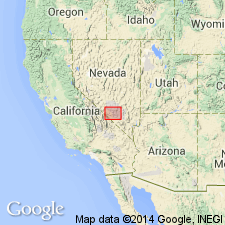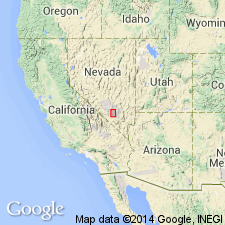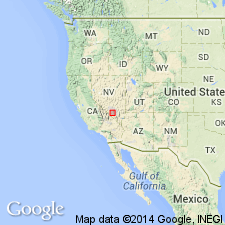
- Usage in publication:
-
- Redrock Valley Tuff*
- Modifications:
-
- Named
- Dominant lithology:
-
- Tuff
- AAPG geologic province:
-
- Great Basin province
Summary:
Previously designated informally as tuff of Redrock Valley. Is oldest ash-flow sheet related to Timber Mountain-Oasis Valley caldera complex. Erupted from Sleeping Butte caldera. Named for exposures (its type locality) on west side of Yucca Flat at hill 5504, 2.4 km east of head of Redrock Valley, northern Tippipah Spring quad, Nye Co, NV, Great Basin province. Consists of one ash-flow tuff, a simple cooling unit. Present in C P Hills, Eleana Range, near Yucca Flat, and on Rainier Mesa. Is 125 m thick at type. Maximum thicknesses of 300 m and 418 m known in subsurface. Total regional extent not known. May be present outside caldera complex. Rests on Paleozoic rocks or on an unnamed tuff sequence. Overlain with local unconformity by unnamed bedded tuff. At type, tuff consists of yellow-gray, nonwelded basal zone of shards several meters thick grading upward to brown densely welded zone with a gray vitrophyre less than 5 m thick. Upper 100 m less welded, and purple, gray, mottled red tuff. Small pumice lenticles 1-2 cm long in devitrified zone contain tiny biotite and hornblende phenocrysts. Quartz is absent to sparse, and can only be seen with hand lens. Distinguishable petrographically from other tuffs. K-Ar age of sanidine in basal vitrophyre is 15.7 m.y.--an age close to onset of volcanism in caldera complex. Reverse remanent magnetization. Cross section. Areal extent map. Modal analyses. Silica range diagram.
Source: GNU records (USGS DDS-6; Denver GNULEX).

- Usage in publication:
-
- Redrock Valley Tuff*
- Modifications:
-
- Areal extent
- AAPG geologic province:
-
- Great Basin province
Summary:
Distribution on both sides of Yucca Flat, Nye Co, and east into Clark Co, NV in the Great Basin province, shown on map. Considered to be a widespread unit, 136 m at type [see Byers and others]. Is one of the 7 units that replaces use of Indian Trail Formation, a name abandoned in this report.
Source: GNU records (USGS DDS-6; Denver GNULEX).

- Usage in publication:
-
- Redrock Valley Tuff*
- Modifications:
-
- Geochronologic dating
- AAPG geologic province:
-
- Great Basin province
Summary:
40Ar/39Ar date on sanidine yielded an age of 15.1 +/-0.05 Ma (Miocene). Study area is southwest Nevada volcanic field, Nye Co, NV, Great Basin province. Oldest unit discussed in report; older than tuff of Yucca Flat.
Source: GNU records (USGS DDS-6; Denver GNULEX).
For more information, please contact Nancy Stamm, Geologic Names Committee Secretary.
Asterisk (*) indicates published by U.S. Geological Survey authors.
"No current usage" (†) implies that a name has been abandoned or has fallen into disuse. Former usage and, if known, replacement name given in parentheses ( ).
Slash (/) indicates name conflicts with nomenclatural guidelines (CSN, 1933; ACSN, 1961, 1970; NACSN, 1983, 2005, 2021). May be explained within brackets ([ ]).

